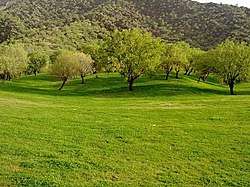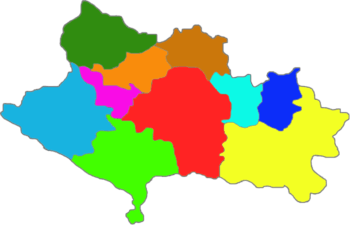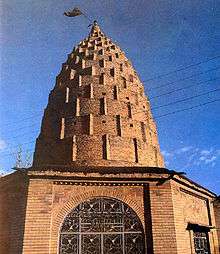Lorestan Province
Lorestan Province (also written Luristan,[3] Lurestan,[3] or Loristan,[3] Persian: استان لرستان, Northern Luri: آستۊن لٛۏرسوݩ, Kurdish: پارێزگای لوڕستان[4]) is a province of western Iran in the Zagros Mountains. The population of Lorestan was estimated at 1,716,527 people in 2006.[1] In 2014 it was placed in Region 4.[5]
Lorestan Province استان لرستان | |
|---|---|
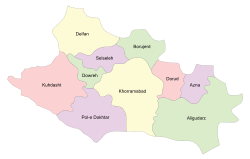 Counties of Lorestan Province | |
 Location of Lorestan Province in Iran | |
| Coordinates: 33.4871°N 48.3538°E | |
| Country | |
| Region | Region 4 |
| Capital | Khorramabad |
| Counties | 11 |
| Area | |
| • Total | 28,294 km2 (10,924 sq mi) |
| Population (2006)[1] | |
| • Total | 1,716,527 |
| • Density | 61/km2 (160/sq mi) |
| Time zone | UTC+03:30 (IRST) |
| • Summer (DST) | UTC+04:30 (IRST) |
| Main language(s) | Luri |
| HDI (2017) | 0.779[2] high · 19th |
Lorestan covers an area of 28,392 km2. The major cities in this province are Khorramabad, Borujerd, Dorud, Aligudarz, Kuhdasht, Azna, Aleshtar, Nurabad, and Pol-e Dokhtar.
Geography and climate
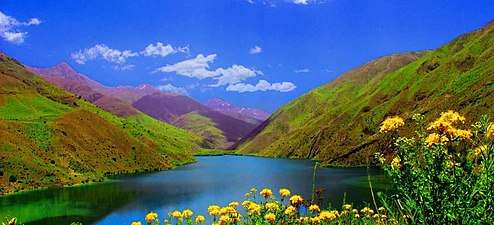
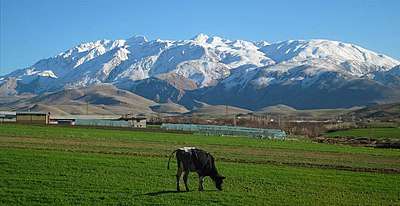
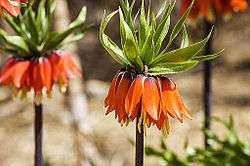
The name Lorestan means "land of the Lurs". In the wider sense it consists of that part of western Iran coinciding with the Ilam Province and extending for about 650 km on a northwest to southeast axis from Kermanshah to Fars, with a breadth of 150–180 km. The terrain consists chiefly of mountains, with numerous ranges, part of the Zagros chain, running northwest to southeast. The central range has many summits that almost reach the line of perpetual snow, rising to 4000 m and more. It feeds the headwaters of Iran's most important rivers, such as the Zayanderud, Jarahi, Karun, Diz, Abi, Karkheh. Between the higher ranges lie many fertile plains and low hilly, well-watered districts.
The highest point of the province is the Oshtorankuh peak at 4,050 m. The low-lying areas being in the southernmost sector of the province are approximately 500 m above sea level. Oak forest covers the outer slopes, together with elm, maple, walnut, and almond trees.[6]
Western Luristan comprises a series of parallel fertile valleys running high in the Zagros mountains. The Pusht-i Kuh region is in the western foothills of the Kabir Kuh range. The Pish-i Kuh region lies to the east of Kabir Kuh. This area had human settlements during the Bronze Age as early as the mid–3rd millennium B.C.
Climatically, the province can be divided into three parts: the mountainous regions, such as Boroujerd, Doroud, Azna, Nourabad and Alishtar experience cold winters and moderate summers. In the central region, the spring season begins from mid-February and lasts till mid May. The township of Khorramabad is in this realm. However, southern areas such as Pol-e-Dokhtar and Papi are under the influence of the warm air currents of Khuzestan, have hot summers and relatively moderate winters.[7]
The climate is generally sub-humid continental with winter precipitation, a lot of which falls as snow (Köppen Csa). Because it lies on the westernmost slopes of the Zagros Mountains, annual precipitation in Lorestan is among the highest anywhere in Iran south of the Alborz Mountains. At Khorramabad, the average annual precipitation totals 530 millimetres (21 inches) of rainfall equivalent, while up to 1270 millimetres (50 inches) may fall on the highest mountains. The months June to September are usually absolutely dry, but Khorramabad can expect 4 inches of rainfall equivalent in December and January.
Temperatures vary widely with the seasons and between day and night. At Khorramabad, summer temperatures typically range from a minimum of 12 °C (54 °F) to a hot maximum of 32 °C (90 °F). In winter, they range from a minimum of -2 °C (28 °F) to a chilly maximum of 8 °C (46 °F).
Administrative divisions
Lorestan includes eleven counties (shahrestans): Aligudarz County, Azna County, Borujerd County, Delfan County, Dorud County, Dowreh County, Khorramabad County, Kuhdasht County, Selseleh County, Poldokhtar County, and as of 2013 Rumeshkan County.[8][9]
Since the creation of the map at the left, Kuhdasht County has been divided into Rumeshkan County and a smaller Kuhdasht County.[9]

History
The ancient history of Lorestan is closely intertwined with the rest of the Ancient Near East. In the 3rd and 4th millennium BC, migrant tribes settled down in the mountainous area of the Zagros Mountains. The Kassites, an ancient people who spoke neither an Indo-European nor a Semitic language, originated in Lorestān. They would control Babylonia after the fall of the Old Babylonian Empire ca. 1531 BC and until ca. 1155 BC.
Parts of Luristan were invaded and settled by the Iranian Medes in the 2nd millennium BC. The Medes absorbed the indigenous inhabitants of the region, primarily the Kassites as well as the Gutians, by the time the area was conquered by the Persians in the 1st millennium BC. In February 2017, archeological discoveries related to the Achaemenid era were made in Lorestan for the first time.[10]
Luristan bronze
Small Luristan bronze artworks, usually dated about 1000 to 650 BC, reached the outside world from the late 1920s and are found in museums all over the world, where they are valued for their vigorous style, with many representations of animals. But actually, the beginning of this bronze-making tradition goes back to the mid–3rd millennium BC.
Archaeologists characterized these techniques by the metallurgical analysis of different artifacts,
We have characterized these practices by the compositional and metallurgical analysis of grave goods from several cemeteries in the region including six dating to different phases of the Bronze Age (Early Dynastic I to Ur ED III, circa 2900–2000 BC)—Kalleh Nisar, Bani Surmah, Chigha Sabz, Kamtarlan, Sardant, and Gulal-i Galbi—and four dating to different phases of the Iron Age (circa 1300 B.C.–600 B.C.)—Bard-i Bal, Kutul-i Gulgul, Sar Kabud, and War Kabud.[11]
Technically, the term 'Luristan bronze' usually refers only to the later bronze objects, although they have many similarities. The earlier bronze objects were made during the Elam period.
Lorestan was successfully integrated into the Achaemenid, Parthian and Sasanian empires. Parts of the region managed to stay independent during the Arab, Seljuk and Mongol invasions.
According to the Encyclopaedia of Islam, the Lurs, previously open adherents of the Ahl-e-Haqq faith, revere bread and fire like the Zoroastrians. "Being split up into numerous tribes and sections, they migrate to their summer pastures as separate bands without overall command. In 1936, Reza Shah's army conquered them, with much bloodshed and starvation, forcing many of the survivors to settle in villages under landlords."[12]
In the early 1930s, when British explorer Freya Stark visited Luristan, she reported that few Europeans had visited the area before her, partly due to its remoteness, but also because of the dangers one could expect to encounter among lawless tribespeople.[13]
Transportation
Roads
Lorestan is located on Tehran-Bandar Emam Khomeyni highway, one of the most important roads in terms of good transportation. The road connects Arak in Markazi Province to Andimeshk in northern Khuzestan via Borujerd, Khorramabad and Pol-e Dokhtar. This highway consists of roads 56 and Road 37 (Iran) with junction at Borujerd. Freeway 5 is the 2nd road for rapid transport between Tehran and Khuzestan with connections in Borujerd and Khorramabad in Lorestan.
Airports
Khorramabad Airport is the only active airport in Lorestan with daily flights to Tehran. The second airport is planned to be built in north of Borujerd.
Railway
Due to its mountainous conditions, Lorestan has one of the important railways in Iran. The Lorestan rail route is 215 km long, with 15 stations having been established. Lorestan has 133 railway tunnels. The railway follows the rivers Dez and Sezar.
Iran Lorestan Railway Dept. | |||||||||||||||||||||||||||||||||||||||||||||||||||||||||||||||||||||||||||||||||||||||||||||||||||||||||||||||||||||||
|---|---|---|---|---|---|---|---|---|---|---|---|---|---|---|---|---|---|---|---|---|---|---|---|---|---|---|---|---|---|---|---|---|---|---|---|---|---|---|---|---|---|---|---|---|---|---|---|---|---|---|---|---|---|---|---|---|---|---|---|---|---|---|---|---|---|---|---|---|---|---|---|---|---|---|---|---|---|---|---|---|---|---|---|---|---|---|---|---|---|---|---|---|---|---|---|---|---|---|---|---|---|---|---|---|---|---|---|---|---|---|---|---|---|---|---|---|---|---|---|
| |||||||||||||||||||||||||||||||||||||||||||||||||||||||||||||||||||||||||||||||||||||||||||||||||||||||||||||||||||||||
People and culture
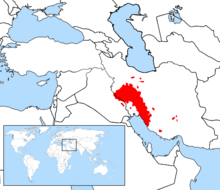
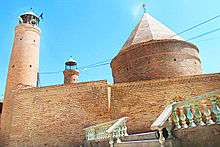

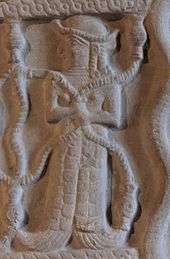
The Lurs constitute part of the southwestern branch of the Iranian peoples, who are spread across the Iranian plateau and beyond, stretching from the Hindu Kush to central Anatolia and from the Caucasus and Central Asia to the Persian Gulf — a region that is sometimes termed Greater Iran.[14] Their language (called Luri or Lurish language) is closely related to Persian, and there are two distinct dialects. "Lur-e-Bozourg" (Greater Lur) is spoken by the Bakhtiaris, and "Lur-e-Kuchik" (Lesser Lur), spoken by the Lurs themselves. People in Borujerd speak in Borujerdi Dialect, a local Lori Persian dialect extracted from Luri. Northwest of Lorestan Province is dominated by Laki speakers. Professor Richard N. Frye wrote that "the Lurs and their dialects are closely related to the Persians of Fars province, and naturally belong to the southwestern branch of the Iranian peoples..."[15]
The overwhelming majority of Lurs are Shia Muslims, with a small minority of Yarsanis of the Laki subgroup. In Khuzestan, Lur tribes are primarily concentrated in the northern part of the province, while in Ilam they are mainly in the southern region.
Before the 20th century the majority of Lurs were nomadic herders, with an urban minority residing in the city of Khorramabad. There were several attempts by the Pahlavi governments to forcibly settle the nomadic segment of the Lur population. Under Reza Shah, these campaigns tended to be unsuccessful. The last Shah of Iran, Mohammad Reza Pahlavi, used less forceful methods along with economic incentives, which met with greater, though not complete, success. By the mid-1980s the vast majority of Lurs had been settled in towns and villages throughout the province or had migrated to the major urban centres.
A number of nomadic Lur tribes continue to exist in the province. Among the settled urban populace the authority of tribal elders still remains a strong influence, though not as dominant as it is among the nomads. As in Bakhtiari Lurs and Kurdish societies, northern Lur women have had much greater freedoms than women in other Iranian groups.
Northern region

In the northern part of Lorestan, formerly known as Lesser Lorestan ("Lur-e-Kuchak"), live the Faylis, divided into the Pishkuh Lurs in the east and Pushtkuh Lurs in the adjoining Iraqi territory in the west.
Lesser Lorestan maintained its independence under a succession of princes of the Khorshidi dynasty, known as Atabegs, from A.D. 1155 to the beginning of the 17th century. Shah Abbas I then removed the last Atabeg, Shah Verdi Khan, and entrusted the government of the province to Hossein Khan Shamlu, the chief of the rival tribe of Shamlu, with the title of Vali in exchange for that of Atabeg. The descendants of Hossein Khan retained the title as governors of the Pushtkuh Lurs, to whom only the denomination of Feili now applies.
Southern region
The southern part of the province, formerly known as Greater Lorestan ("Lur-e-Bozorg"), comprises the Bakhtiari region of the province of Khuzestan and the districts of the Mamasenni and Kuhgilu Lurs, which are in Fars province. At one time, Greater Lorestan formed an independent state under the Fazlevieh Atabegs from A.D. 1160 until 1424. Its capital, Idaj, survives as mounds and ruins at Malamir, sixty miles southeast of the city of Shushtar in Khuzestan.
People
- Grand Ayatollah Borujerdi, religious man
- Prof. Shahin Shojai, leading economist
- Shahmirza Moradi, sorna player
- Nasrollah Kasraian, photographer
- Abdolhossein Zarrinkoob, writer, historian, and critic
- Sayyed Jafar Shahidi, writer, historian, and critic
- Parviz Shahbazi, writer and filmmaker
- Loris Tjeknavorian, Armenian-Iranian composer and conductor
- Mehdi Karroubi, politician
- Qadam Kheyr, local heroine
- Narges Rashidi, actress
Colleges and universities
- Lorestan University
- Grand Ayatollah Borujerdi University of Borujerd
- Lorestan University of Medical Sciences
- Islamic Azad University of Khorram Abad
- Islamic Azad University of Aligudarz
- Islamic Azad University of Borujer
- Islamic Azad University of Dorood
- Payam Nour University of Poldokhtar
- Payam Nour University of Alashtar
- Payam Nour University of Borujerd
- Al-ghadir Applicational Scientific Comprehensive University
- Shahid Madani school of Khoramabad
- Ma’soumeh School of Khoramabad
See also
Gallery
Historical maps
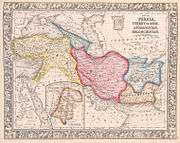 Luristan in 1863, c1860.
Luristan in 1863, c1860. Luristan in 1720.
Luristan in 1720._in_1780-90.jpg) Luristan in 1780-90.
Luristan in 1780-90._in_1831.jpg) Luristan in 1831.
Luristan in 1831.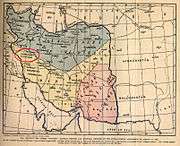 Luristan in The Russo-British Pact in 1907.
Luristan in The Russo-British Pact in 1907.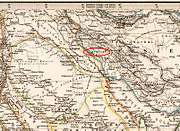 Luristan in 1875.
Luristan in 1875.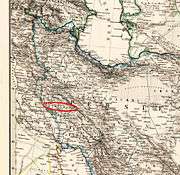 Luristan 1875.
Luristan 1875._in_1706-08.jpg) Luristan in 1706-08.
Luristan in 1706-08.
Photo gallery
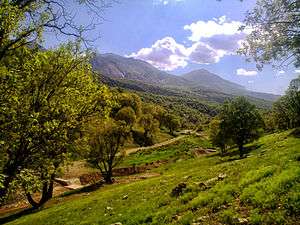 Nojian oak forest Khorramabad county
Nojian oak forest Khorramabad county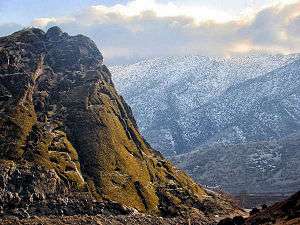 Makhmalkuh Khorramabad county
Makhmalkuh Khorramabad county Gahar Lake Dorud
Gahar Lake Dorud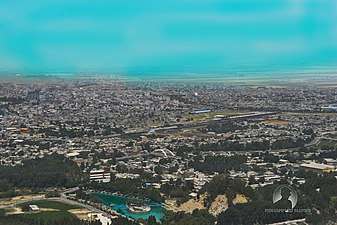 Dorud City Dorud
Dorud City Dorud Sarbazkhane building
Sarbazkhane building Falak ol Aflak Castle
Falak ol Aflak Castle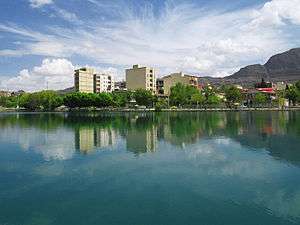 Kiu lake Khorramabad
Kiu lake Khorramabad Tomb of Imamzadeh Ja'far Boroujerd
Tomb of Imamzadeh Ja'far Boroujerd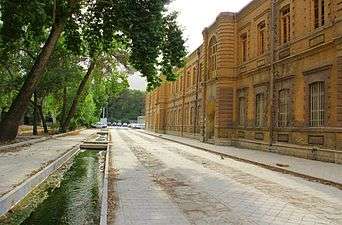 Building in Khorram abad
Building in Khorram abad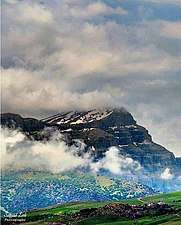 Mount Pariz Dorud
Mount Pariz Dorud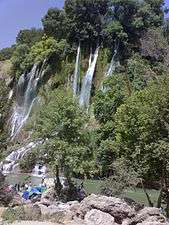 Bisheh waterfall Khorramabad county
Bisheh waterfall Khorramabad county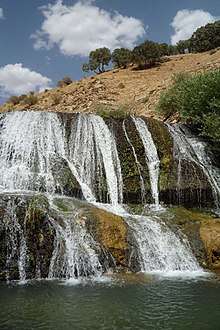 Gerit waterfall
Gerit waterfall Dorud train
Dorud train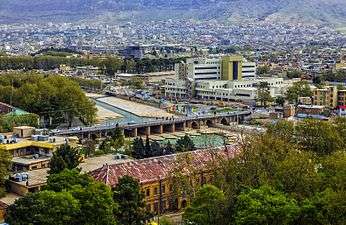 Khorramabad city Khorramabad county
Khorramabad city Khorramabad county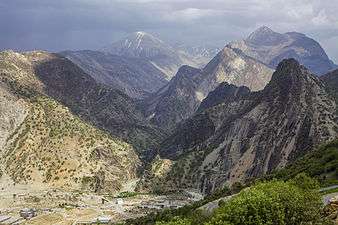
References
- National Census 2006
- "Sub-national HDI - Area Database - Global Data Lab". hdi.globaldatalab.org. Retrieved 2018-09-13.
- "Luristan (Lorestan) Province". Iran Visitor. Archived from the original on 23 March 2016. Retrieved 19 March 2016.
- "ژمارەیەک زیندانی لە زیندانێکی پارێزگای لوڕستان هەڵاتن". Rûdaw (in Kurdish). Retrieved 21 March 2020.
- همشهری آنلاین-استانهای کشور به ۵ منطقه تقسیم شدند [Provinces were divided into 5 regions]. Hamshahri Online (in Persian). 22 June 2014. Archived from the original on 23 June 2014.
- "Archived copy". Archived from the original on 2014-07-14. Retrieved 2014-07-10.CS1 maint: archived copy as title (link) Lorestan region
- Lorestan Land of Culture and Civilization
- "Rumeshkhan: Governance" (in Persian). Lorestan province. Archived from the original on 26 September 2015.
- "وزارت کشور شماره ۱۰۶۲۲۸/ت۴۹۲۴۳هـ" [No. 106228/49243 of the Ministry of Interior] (in Persian). Laws and Regulations Portal of the Islamic Republic of Iran. 26 May 2013. Archived from the original on 28 September 2015.
- "Archeologist: First signs of Achaemenids discovered in Western Iran". irna.ir. Archived from the original on 8 February 2017. Retrieved 28 April 2018.
- Current Projects in Luristan Archived 2017-02-02 at the Wayback Machine penn.museum
- Hamilton Alexander Rosskeen Gibb; Johannes Hendrik Kramers; Bernard Lewis; Charles Pellat; Joseph Schacht (1954). The Encyclopaedia of Islam. Brill. Retrieved 9 April 2011.
- Stark, Freya, The Valley of the Assassins, J. Murray, London, 1934
- Frye, Richard Nelson, Greater Iran, ISBN 1-56859-177-2 p.xi: "... Iran means all lands and peoples where Iranian languages were and are spoken, and where in the past, multi-faceted Iranian cultures existed."
- Frye, Richard N. (1983). Handbuch der Altertumswissenschaft, Part 3, Volume 7. Beck. p. 29. ISBN 978-3406093975.
Bibliography
- W. Barthold (1984). "Luristan and Khuzistan". An Historical Geography of Iran. Translated by Svat Soucek. Princeton University Press. pp. 180–194. ISBN 978-1-4008-5322-9.
External links
| Wikimedia Commons has media related to Lorestan Province. |
Government
Peoples and culture
Arts and culture
- A Lori folk-song sung by Shusha Guppy in the 1970s: I Have Come to Ravish My Heart.
